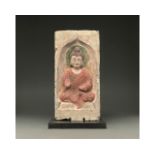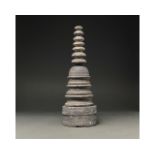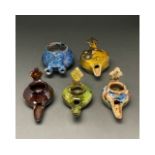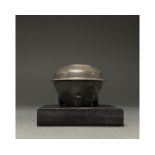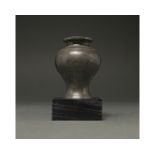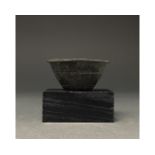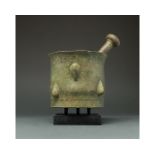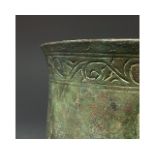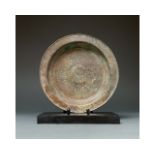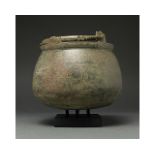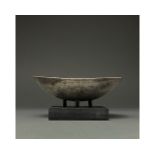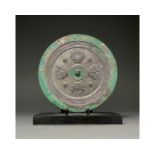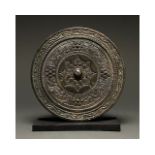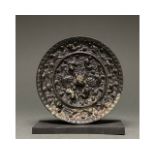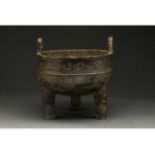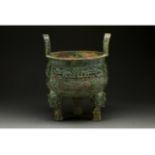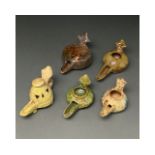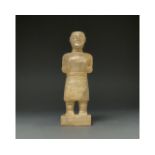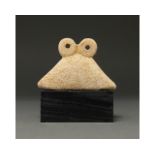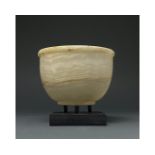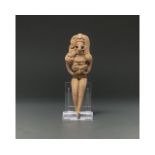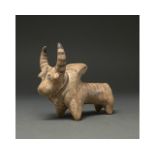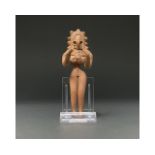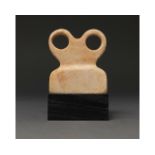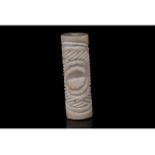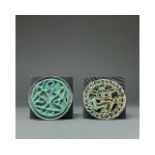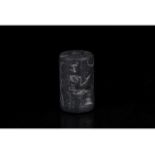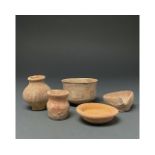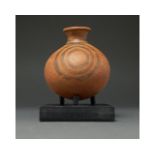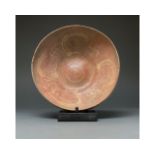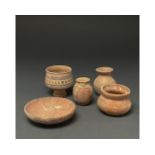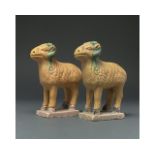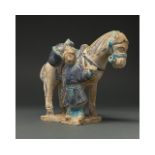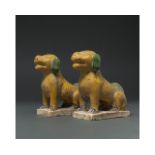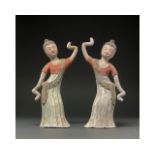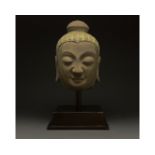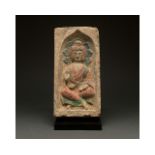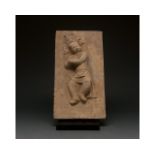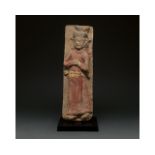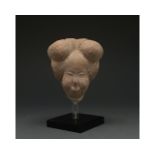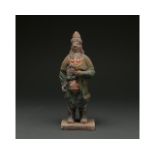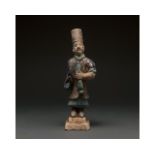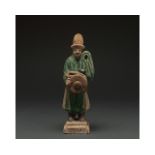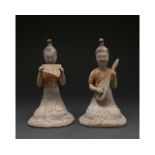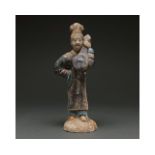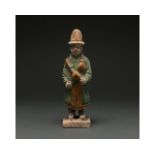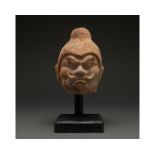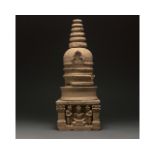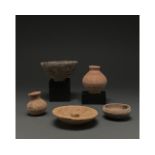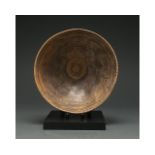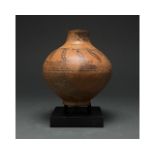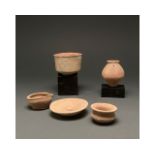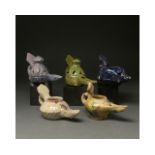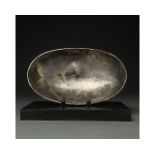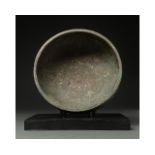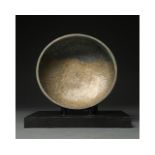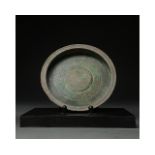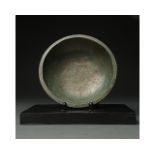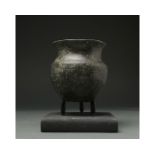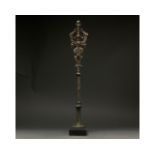Refine your search
Estimate
Category
- Arms, Armour & Militaria (180)
- Jewellery (118)
- Greek, Roman, Egyptian & Other Antiquities (86)
- Chinese Works of Art (55)
- Scientific Instruments (33)
- Sculpture (24)
- Collectables (20)
- Coins (19)
- Ceramics (13)
- Salvage & Architectural Antiques (8)
- Vintage Fashion (8)
- Glassware (7)
- Bank notes (6)
- Islamic Works of Art (6)
- Metalware (6)
- Books & Periodicals (5)
- Models, Toys, Dolls & Games (3)
- Textiles (3)
- Classic Cars, Motorcycles & Automobilia (2)
- Musical Instruments & Memorabilia (2)
- Wines & Spirits (2)
- Clocks (1)
- Kitchenalia (1)
- Silver & Silver-plated items (1)
- List
- Grid
A subscription to the Price Guide is required to view results for auctions ten days or older. Click here for more information
Ca. 500 AD. Chinese Northern Wei Dynasty. A terracotta brick in a cream-coloured fabric featuring a beautiful depiction of a seated buddha with a ...
100-300 AD. Gandharan. A dark grey schist stupa reliquary in three parts comprising superimposed hemispherical segments of progressively smaller s...
ca. 1100 AD. Seljuk. This lot of beautiful medieval Islamic period glazed lamps were probably made under the Seljuk dynasty. Four of these lamps h...
Ca.960-1279 AD. Chinese Song Dynasty. A bronze vessel with a wide, raised mouth, broad, sloping shoulder, truncated conical body and flat base; th...
Ca.960-1279 AD. Chinese Song Dynasty. A bronze vessel with an out-turned rim, constricted neck, globular body, flaring foot and flat base. The sho...
Ca.960-1279 AD. Chinese Song Dynasty. A bronze strainer with an out-turned rim, truncated conical body and flat base featuring numerous rounded pe...
ca. 1100 AD. Seljuk. Beautiful bronze mortar and pestle. The mortar comprises an out-turned rim, cylindrical body and stepped-in foot. The body is...
Ca. 1000 BC. Luristani. A stunning bronze vessel with an out-turned rim, slightly tapering neck, truncated conical body and flat base. The exterio...
ca. 1100 AD. Seljuk. Circular bronze plate with broad lip and wide, flat base. The plate is covered with engraved decoration picked out in silver ...
ca. 1100 AD. Seljuk. A rare bronze situla with a scalloped handle, short, bulging neck, out-flared body and rounded base. The exterior bears an en...
C. 224-651 AD. Sassanian. A silver boat-shaped vessel with a rectangular plan, sloping sides and rounded bottom. The Sassanian empire which ruled ...
Ca. 700 AD. Tang Dynasty. A circular bronze mirror with intricate relief depicting four dragon heads arranged around a central rondel containing a...
Ca. 700 AD. Tang Dynasty. A circular bronze mirror with intricate relief depicting banded decoration including repeating dragons, vegetal motifs, ...
Ca. 700 AD. Tang Dynasty. A circular bronze mirror with intricate relief depicting banded decoration including repeating birds, monkeys, vegetal m...
1300-1100 BC, Late Shang Dynasty. A bronze tripod, generally known as a ding. The object comprises a hemispherical body with shelved rim and two r...
1300-1100 BC, Late Shang Dynasty. A bronze tripod, generally known as a ding. The object comprises a hemispherical body with shelved rim and two r...
ca. 1100 AD. Seljuk. This lot of beautiful medieval Islamic period glazed lamps were probably made under the Seljuk dynasty. Four of these lamps h...
CA. 200 AD. Western Asiatic. Beautiful cream alabaster figurine of a standing male. The figure, who wears a loose tunic, holds his hands by his si...
Ca.4000 BC. Western Asiatic. Attractive creme coloured stone Tell Brak Eye Idol consisting of a traingular and two circular eyes. Idols of this ki...
BACTRIAN ALABASTER VESSEL
ca. 4000 BC. Bactrian. Large cream-coloured alabaster bowl with a round base and curved sides and a thick, rounded rim. This elegant object may ha...
C. 3rd millennium BC. Indus Valley. A lovely buff-coloured handmade fertility idol of characteristically abstract form with delineated legs, curve...
C. 3rd millennium BC. Indus Valley. An creme-coloured ceramic figurine of a zebu with exaggerated crescent horns, painted with stripes to the horn...
C. 3rd millennium BC Indus Valley.. A lovely buff-coloured handmade fertility idol of characteristically abstract form with delineated legs, curve...
Ca.4000 BC. Western Asiatic. Attractive brown stone Tell Brak Eye Idol consisting of a square body with slight shoulders, a short neck and two cir...
C. 3000 BC. Sumerian. Rare cylinder seal of white stone. The pattern comprises an eye within a hatched circular band. Rejoined by a modern conserv...
C. 3rd millennium BC. Ancient Central Asia, Indus Valley. A rare pair of disc-shaped bronze seals with single lug handles on one side. The seal on...
C. 1900-1700 BC. Old Babylonian. A rare cylinder seal of black stone. The design comprises a seated god alongside a goddess who introduces a worsh...
C. 3rd millennium BC. Ancient Central Asia, Indus Valley. A collection of five Indus valley ceramic vessels including (front, L-R): a jar with fla...
Ca. 1400-1200 BC. Canaanite. An unusual bronze age Canaanite painted ceramic vessel in a terracotta fabric comprising an out-turned rim, constrict...
C. 3rd millennium BC. Ancient Central Asia, Indus Valley. A fine example of an Indus Valley civilisation painted bowl with a hemispherical body an...
C. 3rd millennium BC. Ancient Central Asia, Indus Valley. A collection of five Indus valley ceramic vessels including (front, L-R): hemispherical ...
Ca. 1368-1644 AD. Chinese Ming Dynasty. A beautifully crafted pair of ochre-coloured glazed terracotta ceramic rams. The wool of the two rams is d...
Ca. 1368-1644 AD. Chinese Ming Dynasty. Ceramic. This figurine shows a groom, dressed in a dark blue tunic, with light blue trim, a light blue bel...
Ca. 1368-1644 AD. Chinese Ming Dynasty. Two beautifully crafted ochre-coloured glazed terracotta dogs. The dogs are depicted sitting on their haun...
C. AD 618 and 907. Tang Dynasty. A pair of delicate Tang Dynasty dancers with long sleeves. Both dancers are wearing a long flowing gowns with ove...
1368-1850. Ming or Qing dynasty. A pottery head of Buddha in a taupe fabric with a yellow painted topknot (ushnisha), arched brow, heavily lidded,...
C. 386-534 AD. Northern Wei Dynasty. A rectangular painted brick with a buddha within an arched recess. Buddha sits cross-legged, backed by a halo...
Ca.960-1279 AD. Chinese Song Dynasty. A buff-coloured, rectangular brick with a dancer depicted in high relief. The dancer, with turned head, cros...
Ca.960-1279 AD. Chinese Song Dynasty. A cream-coloured, rectangular brick with an attendant figure depicted in high relief. The attendant, looks l...
C. AD 618-907. Tang Dynasty. Terracotta head of a court lady. This beautiful ceramic depicts the full face of a well-off court lady with delicate ...
Ca. 1368-1644 AD. Chinese Ming Dynasty. An elaborately crafted warrior attendant figure dressed and green and orange armour, with a tall conical h...
Ca. 1368-1644 AD. Chinese Ming Dynasty. An elaborately crafted male attendant figure dressed in a light blue tunic, a dark blue overtunic which is...
Ca. 1368-1644 AD. Chinese Ming Dynasty. An elaborately crafted male attendant figure dressed in a dark green tunic with orange accents, black boot...
C. AD 618 and 907. Tang Dynasty. A pair of Tang Dynasty musician ladies. Both musicians are wearing a long flowing gowns with creme skirts and ora...
Ca. 1368-1644 AD. Chinese Ming Dynasty. An elaborately crafted female attendant figure dressed in a dark over-dress with blue buttons, a dark blue...
Ca. 1368-1644 AD. Chinese Ming Dynasty. An elaborately crafted male attendant figure dressed in a dark green tunic with orange accents, black boot...
C. AD 618-907. Tang Dynasty. Large terracotta head of a soldier. The soldier is depicted scowling with a creased brow, fierce eyes, wide nose, cur...
100-300 AD. Gandharan. A superb stone reliquary stupa comprising superimposed disk-shaped segments of progressively smaller size atop a domed towe...
C. 3rd millennium BC. Ancient Central Asia, Indus Valley. A collection of five Indus valley ceramic vessels including (front, L-R): bottle with fl...
C. 3rd millennium BC. Ancient Central Asia, Indus Valley. A fine example of an Indus Valley civilisation painted bowl with a hemispherical body an...
Ca. 1400-1200 BC. Canaanite. An unusual bronze age Canaanite painted ceramic vessel in a light brown fabric comprising a plane rim, narrow neck, g...
C. 3rd millennium BC. Ancient Central Asia, Indus Valley. A collection of five Indus valley ceramic vessels including (front, L-R): a jug with spo...
ca. 1100 AD. Seljuk. This lot of beautiful medieval Islamic period glazed lamps were probably made under the Seljuk dynasty. Three of these lamps ...
C. 224-651 AD. Sassanian. A silver boat-shaped vessel with an elliptical plan, sloping sides and rounded bottom. The Sassanian empire which ruled ...
c. 2000-1000 BC, Amlash culture. Bronze bowl with hemispherical body, undulating sides and simple, flattened rim. The sides are decorated with sim...
c. 2000-1000 BC, Amlash culture. Bronze bowl with hemispherical body, undulating sides and simple, flattened rim. The sides are decorated with sim...
ca. 1100 AD. Seljuk. Circular bronze plate with broad lip and wide, flat base. The interior of the plate features several concentric registers of ...
c. 550 BC–330 BC, Achaemenid. A rare Western Asiatic bronze bowl featuring a hemispherical body, undulating sides and simple, flattened rim. The...
Ca. 1000 BC. Luristani. A bronze vessel with an out-turned rim, tapering neck, truncated globular body and flat base; An engraved band depicting u...
c. 2000-700 BC. Luristan Culture. A rare Bronze sceptre formed from central tube which terminates in a stylised male head, representing the Master...

